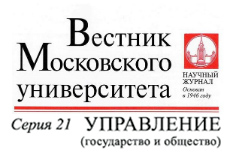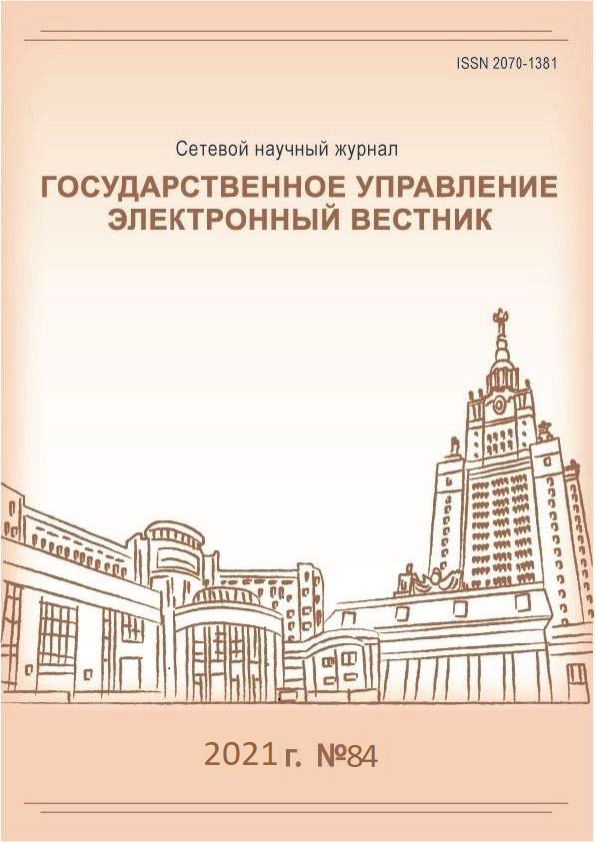Features of Industrial Policy in the Russian Nuclear Industry
Keywords:
Industrial policy, nuclear industry, industrial policy mechanisms, Rosatom, structural policy, vertical and horizontal mechanisms, strategic priorities, nuclear power plantsAbstract
The article is focused on evaluating the effectiveness of Russia’s industrial policy in the nuclear industry in the period from 2008 to 2019. To analyze the effectiveness of industrial policy, the concepts of Warwick's definition and tools of industrial policy and Leibenstein’s concept of X-efficiency are applied. The concept of state industrial policy within the Russian nuclear industry was defined, in particular, the legal framework of the industrial policy of the nuclear industry is considered. The authors highlighted the characteristic features of the Russian nuclear industry. The main characteristics of the Russian state industrial policy are given on the example of the Rosatom state corporation. The effectiveness of the existing industrial policy was analyzed using the approach proposed by the authors. The analysis revealed that vertical support mechanisms used by government to support the “industry champion” proved to be the most effective for developing the nuclear industry, in particular for creating export opportunities and for preserving and developing scientific and technical potential of the nuclear industry. However, the article recognizes the beginning of stagnation in the growth of international orders amount due to changes in the energy markets and the lack of domestic resources to implement the previous vertical industrial policy. It gives the grounds for the transformation of industrial policy towards horizontal mechanisms. The authors of the article propose possible mechanisms and tools for horizontal and vertical industrial policy aimed at implementing the strategy of Rosatom’s diversification using available resources, scientific and technical potential and human capital to overcome a possible crisis. The main trends in the activities of Rosatom state corporation were identified and characterized in accordance with the described features of industrial policy.
References
Кирдина С.Г. Х-эффективность и Х-экономики: синтез теоретических подходов // Terra Economicus. 2007. Т. 5. № 2. С. 9–26.
Кузнецов Б.В., Симачев Ю.В. Эволюция государственной промышленной политики в России // Журнал Новой экономической ассоциации. 2014. № 2(22). С. 152–178.
Минакир П.А. Промышленная политика // Журнал Новой экономической ассоциации. 2014. № 2(22). С. 180–185.
Невская Н.А. Промышленная политика России: содержательный анализ правовой базы // ЦИТИСЭ. 2016. № 3. URL: http://ma123.su/_ld/2/296_11-7.3-_.--_16..pdf
Полтерович В.М. Промышленная политика: рецепты или институты? // Журнал Новой экономической ассоциации. 2014. № 2. С. 190–195.
Симачев Ю., Кузык М., Кузнецов Б., Погребняк Е. Россия на пути к новой технологической промышленной политике: среди манящих перспектив и фатальных ловушек // Форсайт. 2014. Т. 8. № 4. С. 6–23.
Шаститко А.Е. Промышленная и конкурентная политика: от теории к практике взаимодействия // Журнал Новой экономической ассоциации. 2014. № 2(22). С. 205–209.
Aghion P., Cai J., Dewatripont M., Du L., Harrison A., Legros P. Industrial Policy and Competition // American Economic Journal: Macroeconomics. 2015. Vol. 7. No. 4. DOI: 10.1257/mac.20120103.
Aiginger K., Rodrik D. Rebirth of Industrial Policy and an Agenda for the Twenty-First Century // Journal of Industry, Competition and Trade. 2020. No. 20. P. 189–207. DOI: https://doi.org/10.1007/s10842-019-00322-3.
Alder S., Shao L., Zilibotti F. Economic Reforms and Industrial Policy in a Panel of Chinese Cities // Journal of Economic Growth. 2016. No. 21. P. 305–349. DOI: https://doi.org/10.1007/s10887-016-9131-x.
Bianchi P., Labory S. Industrial Policy after the Crisis. Seizing the Future. Cheltenham: Edward Elgar Publishing, 2011. DOI: https://doi.org/10.4337/9780857930491.
Cherif R., Hasanov F. The Return of the Policy That Shall Not Be Named: Principles of Industrial Policy // IMF Working Papers. 2019. DOI: https://doi.org/10.5089/9781498305402.001
Kurdin A., Shastitko A. The New Industrial Policy: A Chance for the BRICS Countries // BRICS Journal of Economics. 2020. Vol. 1. No. 1. P. 60–80. DOI: http://doi.org/10.38050/2712-7508-2020-5.
Leibenstain H. General X-Efficiency Theory and Economic Development. New York: Oxford University Press, 1978.
Lin J.Y. Industrial Policies for Avoiding the Middle-Income Trap: A New Structural Economics Perspective // Journal of Chinese Economic and Business studies. 2017. Vol. 15. No. 1. P. 5–18. DOI: https://doi.org/10.1080/14765284.2017.1287539.
Lin J.Y. New Structural Economics: A Framework for Rethinking Development and Policy. Washington, DC: World Bank, 2012. DOI: https://doi.org/10.1596/9780821389553_ch01
Stiglitz J.E. Industrial Policy, Learning and Development // The Practice of Industrial Policy.
Government — Business Coordination in Africa and East Asia / ed. by Page J., Tarp F. Oxford: Oxford University Press, 2017. P. 23–39.
Warwick K. Beyond Industrial Policy: Emerging Issues and New Trends // OECD Science, Technology and Industry Policy Papers. 2015. No. 2. DOI: https://doi.org/10.1787/5k4869clw0xp-en.
Downloads
Published
Most read articles by the same author(s)
- Alexander A. Kurdin, Anna I. Meleshkina, Sergei I. Fedorov, Adaptation of Russian Automotive Industry to the Impact of New Sanctions , Public Administration. E-journal (Russia): No. 106 (2024)
Similar Articles
- Sergey M. Nikonorov, Anastasiia N. Kulikova, Floating Nuclear Power Plant as a Driver for the Sustainable Development of Arctic Cities (on the Example of Pevek) , Public Administration. E-journal (Russia): No. 107 (2024)
- Sergey E. Trofimov , State Policy of Import Advance in the Russian Oil and Gas Complex , Public Administration. E-journal (Russia): No. 99 (2023)
- Dmitry. А. Vasilyev, State Tariff and Antimonopoly Regulation of the Electric Power Complex: Institutional Aspect , Public Administration. E-journal (Russia): No. 97 (2023)
- Pavel A. Andreev, Igor A. Lavrentiev, Maksim A. Sidorovich, Identification of Modern Industry Specialization of Far East Regions , Public Administration. E-journal (Russia): No. 97 (2023)
- Ekaterina I. Shumskaia, Critique of Neoclassical Premises of Modern Economic Policy in the Context of Human Potential Realization , Public Administration. E-journal (Russia): No. 94 (2022)
- Eugenia L. Moreva, High-Tech Sectors in EAEU: The Regional Governance’ Problems and Opportunities , Public Administration. E-journal (Russia): No. 87 (2021)
- Matvey S. Oborin, Mechanisms for Stimulating Innovative Development of Single-Industry Towns in Arctic Territories , Public Administration. E-journal (Russia): No. 91 (2022)
- Vladimir I. Shmakov, Main Directions of Modern Transformation and Modernization of Russian Society, Ways to Overcome the Systemic Crisis in the Context of Technological Revolution: Alternative Strategic Development Models , Public Administration. E-journal (Russia): No. 105 (2024)
- Сhen Hanzhi, Evgeniya V. Andryushina, The Main Directions of Internationalization Models’ Development of Russian and Chinese Universities , Public Administration. E-journal (Russia): No. 109 (2025)
- Ilya A. Khabarov, In Vector of Political Self-Organization: Current Trends of Municipal Cross-Functional Interaction , Public Administration. E-journal (Russia): No. 92 (2022)
You may also start an advanced similarity search for this article.




